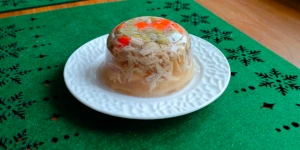
Pork jelly - Galareta wieprzowa
Jump to recipe
Pork jelly is a popular appetizer in Poland. It's not hard to do, but it takes a lot of time. To prepare it, we need pork legs, knuckles, vegetables and water.
The legs collagen slowly infuses into the mixture during the cooking process, causing it to solidify as it gradually cools. This results in a deliciously tender and flavorful dish.
Depending on the region of Poland, it appears under a different name. In Kujawy and Pomerania, it can be found under the name "Zylc". In Wielkopolska, we can meet it under the name "Galart". In the southeast of Poland, it is called "Studzienina" or "Studzinina". The most popular name, however, is "zimne nóżki" (cold legs), "nóżki w galarecie" (legs in jelly) or simply "galareta wieprzowa".
How did "pork jelly" was created?
Jelly was already known in the late Middle Ages. For its production, however, veal meat was used together with poultry meat. Various types of jellies, mainly based on poultry, were served at noble and even royal courts. One of the oldest recipes for various types of jellies and aspics can be found in the cookbook Compendium Ferculorum from 1682. At courts, such jellies were poured into sophisticated forms and in some cases even colored.
At the turn of the last seventy-five years, pork jelly has become more popular among all people due to easy access to pork. In the times of the Polish People's Republic, it became a snack at every possible party.
Today, pork jelly remains a beloved traditional dish in Poland and is often served during holidays and family gatherings.
Recipe informations:
Galareta wieprzowa
- 1.5 kg pork legs (or 2 legs)
- 1 knuckle
- 2-3 carrots
- 1-2 parsley
- 1 celery
- 1 onion
- 2-3 bay leaves
- 4-6 grains of allspice
- salt pepper
